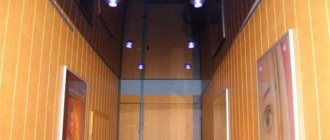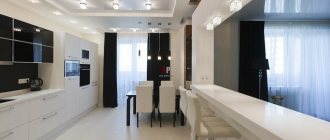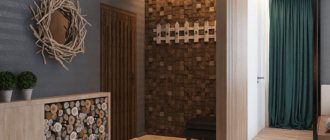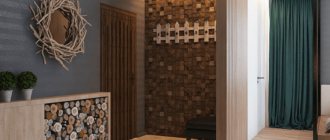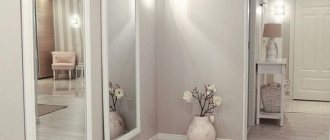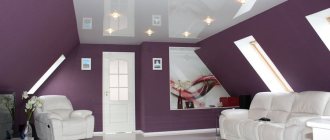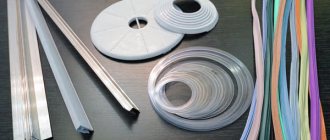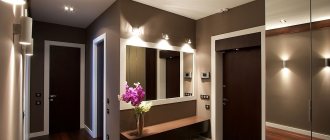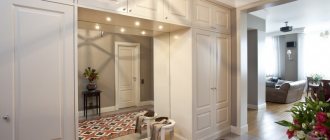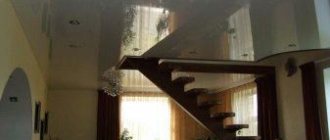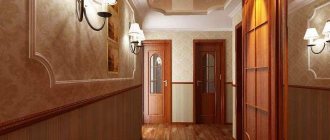Selecting a canvas
Stretch ceilings are made from two types of materials: fabric and film. The first is a dense weave of threads impregnated with polymers for strength. Fabric fabric is more durable. But there are much fewer color options than film. But it can be painted several times.
The fabric has another drawback. It gets dirty faster (due to its mesh structure) and is more difficult to clean: only the dry method is suitable. More dirt from the street gets into the corridor than into other rooms. Therefore, fabric ceilings are not the best choice.
The film sheet is made from polyvinyl chloride. The material is damaged by sharp objects. But it retains water in case of a flood and is easily cleaned with mild detergents. The maximum roll width is 3.3 meters. For standard corridors and hallways this is enough; there is no need to connect several canvases.
PVC film is available in different types of textures. Gloss reflects light best, thereby creating a mirror effect. This surface is selected for low rooms, including hallways with stairs in private houses. The smooth texture has the widest range, including dark, pastel and bright shades.
The matte ceiling does not produce glare. Colored surfaces are more saturated. In pastel color it serves as an excellent background for other furnishings.
The satin surface is similar to fabric. An unobtrusive shine appears due to partial refraction of light. The shade of the ceiling changes slightly at different distances from the lamps. The surface resembles mother-of-pearl.
Design options
Stretch ceilings differ not only in material, but also in the number of levels. The simplest and best option for hallways is a canvas stretched in one tier.
A more complex design - two levels. It is created in the following ways:
- A plasterboard box is erected (this is the lower tier), and a canvas (the upper tier) is stretched from it to the walls. Both fabric and film are used.
- They make a complex frame at different heights and stretch the canvas. With this method, only film is used, since it is more elastic.
The following designs are often found:
- one or more “tablets” - in the shape of a circle, flower, cloud, etc. (spotlights are often built into them);
- perimeter frame;
- division along or across the ceiling, straight or wavy;
- rings.
You don’t have to limit yourself to two levels; you can do three or more. But with each new tier the ceiling height will decrease (by 10-15 cm for the first and at least 3-5 for each next).
In a cramped hallway or narrow corridor, such designs will look out of place.
Color solutions
As a rule, hallways are modest in size. Therefore, light shades are chosen for them.
White color is traditional. The matte texture is practically no different from leveled and plastered. It looks more interesting in satin or gloss. Combines with walls and floors in any color.
Beige has a similar effect to white, but looks cozier. Available in different shades, cooler or warmer.
Light gray also goes with others and expands the space. But it looks more strict.
You can choose delicate pastel shades. For example, blue tones are often chosen. They remind you of the sky and sea, but the room seems cooler. Light green, lavender, ivory, etc. are also suitable. You need to ensure that the suspended ceilings in the hallway are combined with the rest of the decor and style.
Bright colors should be used sparingly as they make the room feel cramped. However, such paintings can become the main accent in the interior. They are used for spacious halls.
It is also possible to combine colors. As a rule, for multi-tiered structures, different tones are chosen to emphasize the level transition.
Hallway Lighting Tips
This room has two features: the lack of natural light and its elongated shape. Properly selected and positioned lamps can compensate for shortcomings.
It’s better not to hang a chandelier, but to make several spotlights. This way it won't be dark in the corners. Location options:
- in a row along the corridor;
- curved line;
- arc;
- rhombus, etc.
Important! Incandescent light bulbs are not suitable for suspended ceilings, as they heat up too much and can damage the ceiling. Therefore, LED, less often halogen or energy-saving lamps are used. This way the temperature around the spot does not rise too much.
Another lighting method is LED strip lighting (around the perimeter or between levels). Used separately or together with the previous option.
The luminous stretch ceiling in the corridor looks interesting. To create it, a translucent film and diodes located behind the surface are used. Not the entire ceiling can glow, but individual lines on it: straight or figuratively curved.
Photo of suspended ceilings in the corridor
Corner ceiling with spot lighting
Lilac two-level composition with lamps along the perimeter of the hallway
Bright photo printing with internal lighting
Subtle pattern on a white stretch fabric in the corridor
Glossy two-tone contrast
Hanging chandelier with additional spotlights on a stretched canvas
White spots in a strict matte tension composition
Accent ceiling in the hallway
The non-standard surface attracts the eye. For walls, floors and wardrobes, choose calm neutral shades to avoid variegation. But even so, the solution is suitable for more spacious corridors. And in small ones it is better to adhere to minimalism and not make the ceiling the main decoration.
With photo printing
The image is applied to all types of materials and textures. The designs look more naturalistic on a matte surface without shine. An interesting effect is obtained on fabric or satin - like a painting on canvas.
For hallways it is not necessary to choose an image in the entire canvas; it is better to leave them for large rooms. A ceiling with a pattern in the corner or a discreet ornament would be more appropriate. The subject can be any, but abstract is more suitable.
Dark
Such colors visually reduce the height of the ceiling, which is why they are chosen for fairly spacious and high rooms (from 3 meters). The effect is less pronounced on a smooth surface, as light and surroundings are reflected in it. Dark matte ceilings are used extremely rarely in the corridor.
Attention! With such canvases it is important to provide sufficient lighting power. Otherwise, the corridor will turn out to be too gloomy.
Wallpaper, furniture and doors should be in calm, light colors so that the room does not seem completely tiny. It is better to use the color of the ceiling in small finishing details. This will unite the room, but not overload it.
The darkest and deepest color is black. It may seem too oppressive and gloomy, but it goes well with all other colors.
Gray is a lighter option. It looks strict and solemn. Goes well with metallic texture film.
Brown color is soft and cozy. It will make the room more comfortable, evoking associations with natural materials.
To prevent the ceiling from being felt above your head, a two-color surface is often made. The most common combination is with white, but other light shades are also suitable.
Complex multi-level
Such ceilings are placed in the most spacious and high hallways (in luxury apartments or cottages). Otherwise, such decor will look inappropriate and pretentious.
By lowering the level, individual zones are highlighted, often thus forming a niche for a wardrobe. Different colors and textures are chosen for the tiers; one of them may have a photo print.
With sophisticated backlight
The soaring ceiling looks impressive. To create it, a special profile is taken, leaving a small space between the film and the walls. An LED strip is placed in the gap and then covered with a translucent insert. As a result, it seems that the ceiling does not rest on the partitions, but floats in the air.
Read more: Floating stretch ceilings
If you take a translucent film and place diode lamps behind it, the entire ceiling will glow. Sometimes similar inserts are made in two-level structures.
If this solution seems too bright, you can install ceiling light lines. Profiles with LED strip are placed behind the tension surface, and after switching on, they are illuminated through it.
Two-level stretch ceilings in the hallway, types of materials, designs, advantages
Hallways are rightfully considered the calling card of the apartment and the face of the owner. This is where the first and most important impression of housing and household members is formed. Therefore, this room should be clean, stylish and beautiful. Two-level stretch ceilings in the hallway can solve this problem. The technology is considered new, although this was used in ancient times, when beautiful fabrics were stretched onto the ceilings in the houses of the rich nobility.
Literally 10 years ago, the need to repair the ceiling in a room terrified the owner. Columns of dust, mountains of cement, paints that, after repairs, lay in terrible stains on the floor. Washing it all out is not a pleasant pleasure. This whole nightmare is a thing of the past for those who decide to install two-level stretch ceilings in the hallway or other rooms. The whole process takes only a few hours and is completely free of dirt and dust. Well, the design of such an innovation will amaze even the most demanding and capricious customers.
Design solutions for hallways
Most people believe that ceiling renovation in the hallway should be done in a minimalist style.
But modern designers do not adhere to such opinions, offering the most extraordinary projects, among which much attention is paid to two-level structures. Two-level stretch ceilings are an opportunity to create an exclusive, unique design for your hallway. After all, the range of paintings is simply huge. Various colors and structures allow you to realize the most extraordinary ideas. Most modern corridors are not large in size. The exception is newfangled cottages and apartments in new buildings. Therefore, in small hallways, two-level ceilings may look a little heavy. But glossy light canvases can visually increase the space of a small corridor.
Spacious hallways provide more space, so you can implement two-level projects, use different colors, and combine fabric textures. On the modern market of materials for this purpose the following canvases are presented:
- glossy;
- matte;
- satin;
- fabric;
- with photo printing;
- embossed, textured.
The color range includes hundreds of shades. Therefore, it is not necessary to create a light, monochromatic stretch ceiling in the hallway. In one area you can use not only two or more levels, but also a combination of several colors. Two-level ceilings look quite harmonious, where dark and light colors are ideally combined, complementing each other. This is another opportunity to create the impression of a tall and spacious room.
The two-level soaring ceiling looks original in the design of the hallways. This is achieved through the use of LED strip, which is attached along the perimeter of the ceiling. When the tape is turned on, it seems that the ceiling is simply floating above your heads in the air.
Using spot lighting, you can slightly shade one part of the ceiling and brighten another. The technology of applying photo printing to canvas looks no less original in the hallway interior. There is no point in creating big paintings. One stroke, broken line, circle, or ornament is enough to make a two-level stretch ceiling look stylish.
Advantages of two-level ceilings for hallways
Professionally installed two-level ceilings in the hallway are not only distinguished by their original style and perfectly flat surface.
This is a fairly durable material that can last for several decades, maintaining its original luster. The material is durable, does not lose its shine, and does not attract dust and dirt, making it easier to maintain. Using any ceiling repair canvases, you can quickly correct all the negative aspects of the old surface. Cracks, smudges, stains, and defects will remain behind the new ceiling.
Quick installation, which can last only a few hours in the complete absence of dirt and dust that accompany repairs using old methods. With the right design, you can completely transform the corridor, making the hallway original, special and individual.
If your own imagination is not enough to create an exclusive design, professionals with rich experience and a lot of unrealized ideas will help you do it. But in order for the two-level suspended ceiling in the hallway to become a source of pride for the owner, it is best to entrust the installation work to professional craftsmen.
The work is not difficult, but it requires not only some experience, but also the availability of special equipment. Most canvases are attached using gas heat guns. Working with them requires certain skills and official permission to avoid negative consequences and damage to the canvas. This is the most cost-effective solution for quickly repairing the ceiling in your own hallway.
Solutions for a narrow long corridor and a small hallway
For problem areas, there are recommendations that allow you to visually compensate for deficiencies. If the corridor is narrow and long, it is not advisable to choose a glossy surface. The room will seem even more cramped and high (like a well).
In such cases, techniques are chosen that allow the walls to be visually moved apart. Here are some of them:
- Cross stripes on the ceiling. They can be created by soldering fabrics.
- Arrangement of lamps in an arc.
- Choosing the same color for the ceiling and long wall (so the boundaries between them are erased).
- Pattern in the form of stripes, cross beams, etc.
- A two-level ceiling with several “cut out” diamonds or squares.
- Glowing lines running parallel to short walls.
For a small hallway (for example, like in a Khrushchev building), if it is not elongated, a glossy texture is suitable. Satin would also be a good choice. The preferred colors are white and light cool tones (for example, gray and blue). If you choose the same color for the walls and cabinet, the boundaries of the room will blur and it will seem more spacious. And so that the interior does not seem boring, it is worth adding bright accents (for example, a picture or mirror in a dark frame, a vase or a key holder).
Designer recommendations
To create a stylish and cozy hallway, do not get carried away with complex shapes or bright colors. These rooms are small, so the design should be discreet.
First of all, they take into account the features of the corridor, how elongated or wide it is, the height of the ceiling, etc. The texture of the ceiling and how dark or bright it can be depend on this. For example, for small hallways a white glossy ceiling is chosen, while for larger ones a light matte surface is suitable.
The second important point is the color scheme. When selecting, flooring and furniture are taken into account. Not contrasting, but complementary combinations (close shades) look better.
You should not overload such problematic rooms as corridors with finishing. Choose the ceiling to match the style of the intended interior, but do not make it too complicated. Let the canvas complement the overall idea without drawing attention to itself.
The hallway is the first thing guests see when entering the house; it forms the overall impression. This room deserves no less attention than others.
